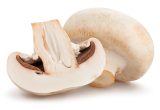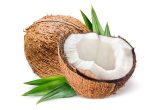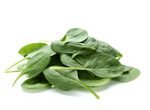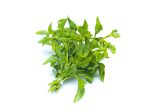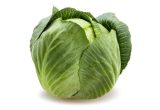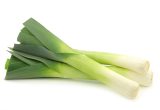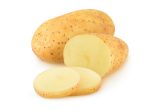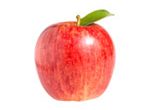Jerusalem artichoke

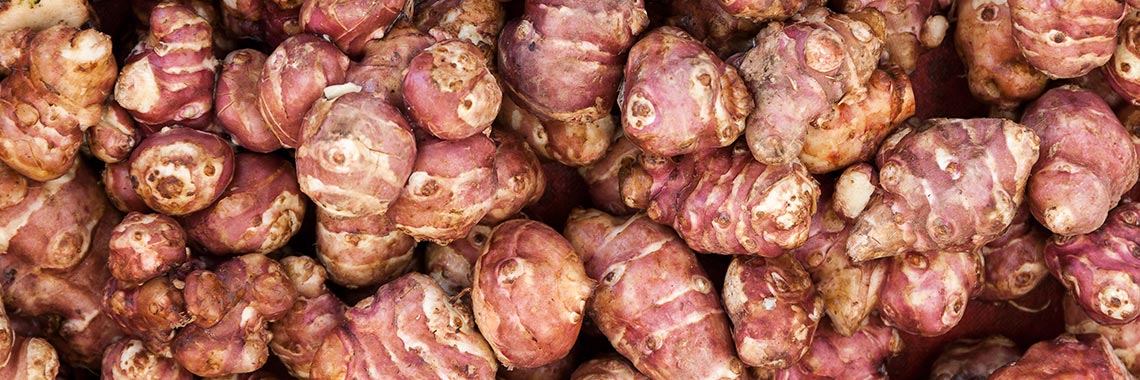
Description
- Jerusalem artichoke (Helianthus tuberosus L.) belongs to the Asteraceae family.
- It is grown in Europe and other parts of the world (Radulovic, 2014).
- It is believed to originate in eastern North America (Bock, 2014).
PHYSICAL AND ORGANOLEPTIC CHARACTERISTICS
- The volatile compounds of the tuber were isolated and identified: a total of 195 constituents were identified, representing between 88 and 93% of the composition. The main substances are β-bisabolene,undecanal, α-pinene, kauran-16-ol, 2-pentylfuran and (E)-tetradec-2-enal (Radulovic, 2014).
- Other rarer components characteristic of the species Helianthus were detected: helianthol A, dihydroeuparin, euparin, desmethoxyencecalin, desmethylencecalin and an isomer of desmethylencecalin (Radulovic, 2014).
- Its flesh is white while its skin can be white, red or purple (Catana, 2018). This difference in colour results from the presence of anthocyanins (Gao, 2020).
- It is irregularly shaped and its firm flesh is a sign of freshness (Fondation Louis Bonduelle, 2020).
COMPOSITION CHARACTERISTICS (excluding macronutrients, vitamins and minerals)
- Jerusalem artichoke was studied for its concentration of total phenols, phenolic acids and organic acids according to the harvesting period. The results indicate that the concentration of total phenols, phenolic acids and citric acid is higher in autumn than in spring, except for malic acid where the opposite is observed (Bach, 2013).
- The main phenolic acids found in Jerusalem artichoke are chlorogenic acid, caffeic acid and the isomers of dicafeoyl 1,5-diCQA and 3,5-diCQA (Showkat, 2019).
- Flavonoids, such as catechins and leuco-anthocyanins, have also been identified in Jerusalem artichoke (Danilcenko, 2017).
- Phenolic compounds give it antioxidant activity (Showkat, 2019).
- Jerusalem artichoke is rich in inulin (80-85%), a polysaccharide composed of D-fructose units linked by β-(2-1) bonds (Dias, 2016 ; Luo, 2018). Inulin stimulates the growth of beneficial colonic bacteria and is used as a prebiotic (Drabinska, 2016). In addition, it can be used to replace sugar in diabetic patients and has antioxidant activity (Dias, 2016).
- During storage of the tubers, the inulin depolymerises and the soluble sugar content increases. Lowering the storage temperature slows down this phenomenon. Storage at -18°C stops it almost entirely (Maicaurkaew, 2017).
- Recently, the compound methyl 2-(4′-methoxy-4′-26 oxobutanamide) benzoate was identified in Jerusalem artichoke. This compound exhibits anti-inflammatory effects and may be involved in reducing the phenomenon of insulin resistance (Jung, 2016).
RAW
The following values are approximate and depend on variety, season, ripeness, cultivation conditions, etc.
Raw Jerusalem artichoke provides an average of 60.70 calories (kcal) per 100 g, i.e. 257 kJ per 100 g. One Jerusalem artichoke weighs on average 500 g, which represents an energy intake of 303.50 g when raw.
COMPOSITION TABLE
For each nutrient, the tables provide information on the content, minimum and maximum values, as well as the percentage of the Dietary Reference Values (DRVs) per 100 g net of raw Jerusalem artichoke.
MACRONUTRIENTS
| Constituent (g) | Average content |
Min-Max per 100g |
DRV% |
|---|---|---|---|
| Water | 80,1 | 78 - 85,70 | - |
| Fibers | 2,10 | 1,60 - 3,10 | - |
| Carbohydrates | 11,50 | - | 4,42 |
| Sugars | 9,60 | - | 10,67 |
| Lipids | 0,31 | 0,01 - 0,60 | 0,44 |
| Saturated fat | 0,11 | NC - 0,15 | 0,55 |
| Protein | 1,94 | 1,88 - 2,50 | 3,88 |
| Constituent (g) | Amount | Min-Max | DRV% |
|---|---|---|---|
| Water | Ciqual 2020 | - | - |
| Fibers | Ciqual 2020 | - | - |
| Carbohydrates | Ciqual 2020 | - | Règlement (UE) N°1169/2011 du parlement Européen, et du conseil du 25 octobre 2011 |
| Sugars | Ciqual 2020 | - | Règlement (UE) N°1169/2011 du parlement Européen, et du conseil du 25 octobre 2011 |
| Lipids | Ciqual 2020 | - | Règlement (UE) N°1169/2011 du parlement Européen, et du conseil du 25 octobre 2011 |
| Saturated fat | Ciqual 2020 | - | Règlement (UE) N°1169/2011 du parlement Européen, et du conseil du 25 octobre 2011 |
| Protein | Ciqual 2020 | - | Règlement (UE) N°1169/2011 du parlement Européen, et du conseil du 25 octobre 2011 |
Zoom on carbohydrates
- The energy of raw Jerusalem artichoke comes mainly from its carbohydrates, at 11.50 g per 100 g.
- This amount is well above the average carbohydrate content in raw vegetables (4.45 g per 100 g) but below that in potatoes and tubers (26.97 g per 100 g).
Zoom on fibres
- Raw Jerusalem artichoke contains slightly less fibre (2.10 g per 100 g) than the average amount found in raw vegetables (2.43 g per 100 g) and in potatoes and tubers (3.04 g per 100 g)
Zoom on proteins
- Its protein content (1.94 g per 100 g) is higher than the average amount present in raw vegetables (1.87 g per 100 g) but lower than that in potatoes and tubers (2.66 g per 100 g)
Zoom on lipids
- The amount of lipids in raw Jerusalem artichoke (0.31 g per 100 g) is much lower than in potatoes and tubers (5.47 g per 100 g).
- Raw Jerusalem artichoke can be described as fat-free as it contains no more than 0.5 g of fat per 100 g.
MINERALS AND TRACE ELEMENTS
| Constituent | Average content |
Min-Max per 100g |
DRV% |
|---|---|---|---|
| Calcium (mg) | 21 | 13 - 40 | 2,63 |
| Chloride (mg) | - | - | - |
| Copper (mg) | 0,13 | 0,12 - 0,14 | 13 |
| Iron (mg) | 2 | 0,58 - 3,40 | 14,29 |
| Iodine (µg) | 0,10 | 0,06 - 1,20 | 0,07 |
| Magnesium (mg) | 16,50 | 12,10 - 19,60 | 4,40 |
| Manganese (mg) | 0,06 | - | 3 |
| Phosphorus (mg) | 75,20 | 51,50 - 132 | 10,74 |
| Potassium (mg) | 495 | 429 - 735 | 24,75 |
| Selenium (µg) | 0,03 | NC - 0,20 | 0,05 |
| Sodium (mg) | 3,50 | 1,80 - 5,30 | - |
| Zinc (mg) | 0,11 | 0,10 - 0,12 | 1,10 |
| Constituent | Amount | Min-Max | DRV% |
|---|---|---|---|
| Calcium (mg) | Ciqual 2020 | - | Règlement (UE) N°1169/2011 du parlement Européen, et du conseil du 25 octobre 2011 |
| Chloride (mg) | Ciqual 2020 | - | Règlement (UE) N°1169/2011 du parlement Européen, et du conseil du 25 octobre 2011 |
| Copper (mg) | Ciqual 2020 | - | Règlement (UE) N°1169/2011 du parlement Européen, et du conseil du 25 octobre 2011 |
| Iron (mg) | Ciqual 2020 | - | Règlement (UE) N°1169/2011 du parlement Européen, et du conseil du 25 octobre 2011 |
| Iodine (µg) | Ciqual 2020 | - | Règlement (UE) N°1169/2011 du parlement Européen, et du conseil du 25 octobre 2011 |
| Magnesium (mg) | Ciqual 2020 | - | Règlement (UE) N°1169/2011 du parlement Européen, et du conseil du 25 octobre 2011 |
| Manganese (mg) | Ciqual 2020 | - | Règlement (UE) N°1169/2011 du parlement Européen, et du conseil du 25 octobre 2011 |
| Phosphorus (mg) | Ciqual 2020 | - | Règlement (UE) N°1169/2011 du parlement Européen, et du conseil du 25 octobre 2011 |
| Potassium (mg) | Ciqual 2020 | - | Règlement (UE) N°1169/2011 du parlement Européen, et du conseil du 25 octobre 2011 |
| Selenium (µg) | Ciqual 2020 | - | Règlement (UE) N°1169/2011 du parlement Européen, et du conseil du 25 octobre 2011 |
| Sodium (mg) | Ciqual 2020 | - | - |
| Zinc (mg) | Ciqual 2020 | - | Règlement (UE) N°1169/2011 du parlement Européen, et du conseil du 25 octobre 2011 |
Zoom on minerals and trace elements
- Raw Jerusalem artichoke is a source of potassium because it provides 24.75% of DRVs, i.e. 495 mg per 100 g.
- It contains a significant amount of iron, copper and phosphorus. It provides the equivalent of:
- 14.29% of DRVs for iron, i.e. 2 mg per 100 g;
- 13% of DRVs for copper, i.e. 0.13 mg per 100 g;
- 10.74% of DRVs for phosphorus, i.e. 75.20 mg per 100 g.
- The quantity of other minerals and trace elements represents less than 5% of DRVs.
VITAMINS
| Constituent | Average content |
Min-Max per 100g |
DRV% |
|---|---|---|---|
| Provitamin A Beta-carotene (µg) | 12 | - | - |
| Vitamin A equivalent (µg) | 2 | - | 0,25 |
| Vitamin B1 (mg) | 0,14 | 0,067 - 0,20 | 12,73 |
| Vitamin B2 (mg) | 0,058 | 0,046 - 0,065 | 4,14 |
| Vitamin B3 (mg) | 1,30 | 1,12 - 1,56 | 8,13 |
| Vitamin B5 (mg) | 0,39 | 0,38 - 0,40 | 6,50 |
| Vitamin B6 (mg) | 0,084 | 0,077 - 0,09 | 6 |
| Vitamin B9 (µg) | 24,50 | 13 - 57 | 12,25 |
| Vitamin C (mg) | 5 | 4 - 8 | 6,25 |
| Vitamin E (mg) | 0,17 | 0,13 - 0,20 | 1,42 |
| Vitamin K1 (µg) | 0,10 | - | 0,13 |
| Constituent | Amount | Min-Max | DRV% |
|---|---|---|---|
| Provitamin A Beta-carotene (µg) | Ciqual 2020 | - | - |
| Vitamin A equivalent (µg) | Calcul à partir de la valeur Provitamine A Béta-carotène* | - | Règlement (UE) N°1169/2011 du parlement Européen, et du conseil du 25 octobre 2011 |
| Vitamin B1 (mg) | Ciqual 2020 | - | Règlement (UE) N°1169/2011 du parlement Européen, et du conseil du 25 octobre 2011 |
| Vitamin B2 (mg) | Ciqual 2020 | - | Règlement (UE) N°1169/2011 du parlement Européen, et du conseil du 25 octobre 2011 |
| Vitamin B3 (mg) | Ciqual 2020 | - | Règlement (UE) N°1169/2011 du parlement Européen, et du conseil du 25 octobre 2011 |
| Vitamin B5 (mg) | Ciqual 2020 | - | Règlement (UE) N°1169/2011 du parlement Européen, et du conseil du 25 octobre 2011 |
| Vitamin B6 (mg) | Ciqual 2020 | - | Règlement (UE) N°1169/2011 du parlement Européen, et du conseil du 25 octobre 2011 |
| Vitamin B9 (µg) | Ciqual 2020 | - | Règlement (UE) N°1169/2011 du parlement Européen, et du conseil du 25 octobre 2011 |
| Vitamin C (mg) | Ciqual 2020 | - | Règlement (UE) N°1169/2011 du parlement Européen, et du conseil du 25 octobre 2011 |
| Vitamin E (mg) | Ciqual 2020 | - | Règlement (UE) N°1169/2011 du parlement Européen, et du conseil du 25 octobre 2011 |
| Vitamin K1 (µg) | Ciqual 2020 | - | Règlement (UE) N°1169/2011 du parlement Européen, et du conseil du 25 octobre 2011 |
Zoom on vitamins
- Raw Jerusalem artichoke contains a significant amount of vitamin B1 and vitamin B9. It provides the equivalent of:
- 12.73% of DRVs for vitamin B1, i.e. 0.14 mg per 100 g;
- 12.25% of DRVs for vitamin B9, i.e. 24.50 µg per 100 g.
- It also provides the equivalent of 8.13% of DRVs for vitamin B3, i.e. 1.30 mg per 100 g.
- The amount of other vitamins is less than 7% of DRVs.
*Calculation made: Beta Carotene / 6 + retinol
POLYPHENOLS
COOKED
The following values are approximate and depend on variety, season, ripeness, cultivation conditions, etc.
Cooked Jerusalem artichoke provides an average of 81.90 calories (kcal) per 100 g, or 346 kJ. One Jerusalem artichoke weighs on average 500 g, which represents an energy intake of 409.50 kcal when cooked.
COMPOSITION TABLES
For each nutrient, the tables provide information on the content, minimum and maximum values, as well as the percentage of Dietary Reference Values (DRVs) per 100 g net of cooked Jerusalem artichoke.
MACRONUTRIENTS
| Constituent (g) | Average content |
Min-Max per 100g |
DRV% |
|---|---|---|---|
| Water | 80,20 | 78 - NC | - |
| Fibers | 2,20 | 1,60 - NC | - |
| Carbohydrates | 16 | - | 6,15 |
| Sugars | 9,60 | - | 10,67 |
| Lipids | 0,70 | 0,01 - NC | 1 |
| Saturated fat | - | - | - |
| Protein | 1,80 | NC - 2 | 3,60 |
| Constituent (g) | Amount | Min-Max | DRV% |
|---|---|---|---|
| Water | Ciqual 2020 | - | - |
| Fibers | Ciqual 2020 | - | - |
| Carbohydrates | Ciqual 2020 | - | Règlement (UE) N°1169/2011 du parlement Européen, et du conseil du 25 octobre 2011 |
| Sugars | Ciqual 2020 | - | Règlement (UE) N°1169/2011 du parlement Européen, et du conseil du 25 octobre 2011 |
| Lipids | Ciqual 2020 | - | Règlement (UE) N°1169/2011 du parlement Européen, et du conseil du 25 octobre 2011 |
| Saturated fat | Ciqual 2020 | - | Règlement (UE) N°1169/2011 du parlement Européen, et du conseil du 25 octobre 2011 |
| Protein | Ciqual 2020 | - | Règlement (UE) N°1169/2011 du parlement Européen, et du conseil du 25 octobre 2011 |
Zoom on carbohydrates
- The energy of cooked Jerusalem artichoke comes mainly from its carbohydrates, at 16 g per 100 g.
- This is well above the average amount of carbohydrates in cooked vegetables (4.85 g per 100 g) but below that in potatoes and tubers (26.97 g per 100 g).
Zoom on fibres
- Cooked Jerusalem artichoke contains 2.20 g of fibre.
- This amount is lower than the average quantity found in cooked vegetables (2.89 g per 100 g) and potatoes and tubers (3.04 g per 100 g).
Zoom on proteins
- Its protein content (1.80 g per 100 g) is lower than the average amount present in cooked vegetables (2 g per 100 g) and in potatoes and tubers (2.66 g per 100 g)
Zoom on lipids
- The amount of fat in cooked Jerusalem artichoke (0.70 g per 100 g) is lower than the average quantity in cooked vegetables (2 g per 100 g) and in potatoes and tubers (2.66 g per 100 g)
- Cooked Jerusalem artichoke is low in fat* as it contains no more than 3 g per 100 g.
*Regulation (EC) No 1924/2006 of the European Parliament and of the Council of 20 December 2006 on nutrition and health claims made on foods.
MINERALS AND TRACE ELEMENTS
| Constituent | Average content |
Min-Max per 100g |
DRV% |
|---|---|---|---|
| Calcium (mg) | 32,90 | 14 - NC | 4,11 |
| Chloride (mg) | - | - | - |
| Copper (mg) | < 0,10 | NC - 0,14 | - |
| Iron (mg) | 0,20 | NC - 3,40 | 1,43 |
| Iodine (µg) | < 10 | - | - |
| Magnesium (mg) | 14,10 | NC - 17 | 3,76 |
| Manganese (mg) | < 0,10 | 0 - NC | - |
| Phosphorus (mg) | 64 | NC - 78 | 9,14 |
| Potassium (mg) | 452 | 429 - NC | 22,60 |
| Selenium (µg) | - | - | - |
| Sodium (mg) | 35,90 | 4 - NC | - |
| Zinc (mg) | 0,34 | 0,12 - NC | 3,40 |
| Constituent | Amount | Min-Max | DRV% |
|---|---|---|---|
| Calcium (mg) | Ciqual 2020 | - | Règlement (UE) N°1169/2011 du parlement Européen, et du conseil du 25 octobre 2011 |
| Chloride (mg) | Ciqual 2020 | - | Règlement (UE) N°1169/2011 du parlement Européen, et du conseil du 25 octobre 2011 |
| Copper (mg) | Ciqual 2020 | - | Règlement (UE) N°1169/2011 du parlement Européen, et du conseil du 25 octobre 2011 |
| Iron (mg) | Ciqual 2020 | - | Règlement (UE) N°1169/2011 du parlement Européen, et du conseil du 25 octobre 2011 |
| Iodine (µg) | Ciqual 2020 | - | Règlement (UE) N°1169/2011 du parlement Européen, et du conseil du 25 octobre 2011 |
| Magnesium (mg) | Ciqual 2020 | - | Règlement (UE) N°1169/2011 du parlement Européen, et du conseil du 25 octobre 2011 |
| Manganese (mg) | Ciqual 2020 | - | Règlement (UE) N°1169/2011 du parlement Européen, et du conseil du 25 octobre 2011 |
| Phosphorus (mg) | Ciqual 2020 | - | Règlement (UE) N°1169/2011 du parlement Européen, et du conseil du 25 octobre 2011 |
| Potassium (mg) | Ciqual 2020 | - | Règlement (UE) N°1169/2011 du parlement Européen, et du conseil du 25 octobre 2011 |
| Selenium (µg) | Ciqual 2020 | - | Règlement (UE) N°1169/2011 du parlement Européen, et du conseil du 25 octobre 2011 |
| Sodium (mg) | Ciqual 2020 | - | - |
| Zinc (mg) | Ciqual 2020 | - | Règlement (UE) N°1169/2011 du parlement Européen, et du conseil du 25 octobre 2011 |
Zoom on minerals and trace elements
- Cooked Jerusalem artichoke is a source of potassium as it provides the equivalent of 22.60% of DRVs, i.e. 452 mg per 100 g.
- It provides the equivalent of 9.14% of DRVs for phosphorus, i.e. 64 mg per 100 g.
- The quantity of other minerals and trace elements represents less than 5% of DRVs.
VITAMINS
| Constituent | Average content |
Min-Max per 100g |
DRV% |
|---|---|---|---|
| Provitamin A Beta-carotene (µg) | < 50 | 0 - NC | - |
| Vitamin A equivalent (µg) | < 8,33 | 0 - NC | - |
| Vitamin B1 (mg) | < 0,05 | NC - 0,20 | - |
| Vitamin B2 (mg) | 0,03 | NC - 0,06 | 2,14 |
| Vitamin B3 (mg) | 0,05 | NC - 1,30 | 0,31 |
| Vitamin B5 (mg) | 0,38 | NC - 0,40 | 6,33 |
| Vitamin B6 (mg) | 0,04 | NC - 0,077 | 2,86 |
| Vitamin B9 (µg) | 44,30 | 13 - NC | 22,15 |
| Vitamin C (mg) | 3,20 | NC - 4 | 4 |
| Vitamin E (mg) | 0,19 | - | 1,58 |
| Vitamin K1 (µg) | 0,10 | - | 0,13 |
| Constituent | Amount | Min-Max | DRV% |
|---|---|---|---|
| Provitamin A Beta-carotene (µg) | Ciqual 2020 | - | - |
| Vitamin A equivalent (µg) | Calcul à partir de la valeur Provitamine A Béta-carotène* | - | Règlement (UE) N°1169/2011 du parlement Européen, et du conseil du 25 octobre 2011 |
| Vitamin B1 (mg) | Ciqual 2020 | - | Règlement (UE) N°1169/2011 du parlement Européen, et du conseil du 25 octobre 2011 |
| Vitamin B2 (mg) | Ciqual 2020 | - | Règlement (UE) N°1169/2011 du parlement Européen, et du conseil du 25 octobre 2011 |
| Vitamin B3 (mg) | Ciqual 2020 | - | Règlement (UE) N°1169/2011 du parlement Européen, et du conseil du 25 octobre 2011 |
| Vitamin B5 (mg) | Ciqual 2020 | - | Règlement (UE) N°1169/2011 du parlement Européen, et du conseil du 25 octobre 2011 |
| Vitamin B6 (mg) | Ciqual 2020 | - | Règlement (UE) N°1169/2011 du parlement Européen, et du conseil du 25 octobre 2011 |
| Vitamin B9 (µg) | Ciqual 2020 | - | Règlement (UE) N°1169/2011 du parlement Européen, et du conseil du 25 octobre 2011 |
| Vitamin C (mg) | Ciqual 2020 | - | Règlement (UE) N°1169/2011 du parlement Européen, et du conseil du 25 octobre 2011 |
| Vitamin E (mg) | Ciqual 2020 | - | Règlement (UE) N°1169/2011 du parlement Européen, et du conseil du 25 octobre 2011 |
| Vitamin K1 (µg) | Ciqual 2020 | - | Règlement (UE) N°1169/2011 du parlement Européen, et du conseil du 25 octobre 2011 |
Zoom on vitamins
- Cooked Jerusalem artichoke is a source of vitamin B9 as it provides the equivalent of 22.15% of DRVs, i.e. 44.30 µg per 100 g.
- It provides the equivalent of 6.33% of DRVs for vitamin B5, i.e. 0.38 mg per 100 g.
- The amount of other vitamins is less than 5% of DRVs.
*Calculation made: Beta Carotene / 6 + retinol
POLYPHENOLS
Nutrition and health claims
According to the definitions of nutrition claims as presented in Regulation (EC) No 1924/2006 on nutrition and health claims, and in view of the composition of raw Jerusalem artichoke, the following claims may be used:
NUTRITION CLAIMS OF RAW JERUSALEM ARTICHOKE
- Fat-free (100 g of raw Jerusalem artichoke contain less than 0.5 g of fat)
- Source of potassium (100 g of raw Jerusalem artichoke provide more than 15% of DRVs)
HEALTH CLAIMS (for a consumption of 100 g of raw Jerusalem artichoke)
Potassium
- Potassium contributes to:
- normal functioning of the nervous system,
- normal muscle function,
- maintenance of normal blood pressure.
Nutrition and health claims
According to the definitions of nutrition claims as set out in Regulation (EC) No 1924/2006 on nutrition and health claims, and in view of the composition of cooked Jerusalem artichoke, the following claims may be used:
NUTRITION CLAIMS OF COOKED JERUSALEM ARTICHOKE
- Fat-free (100 g of cooked Jerusalem artichoke do not contain more than 0.5 g of fat)
- Source of potassium (100 g of cooked Jerusalem artichoke provide more than 15% of DRVs)
- Source of vitamin B9 (100 g of cooked Jerusalem artichoke provide more than 15% of DRVs)
HEALTH CLAIMS (for a consumption of 100 g of cooked Jerusalem artichoke)
Potassium
- Potassium contributes to:
- normal functioning of the nervous system,
- normal muscle function,
- maintenance of normal blood pressure.
Folates or vitamin B9
- Folates contribute to:
- maternal tissue growth during pregnancy,
- normal amino acid synthesis,
- normal blood formation,
- normal homocysteine metabolism,
- normal psychological function,
- normal function of the immune system,
- reduction of tiredness and fatigue.
- Folates have a role in the process of cell division.
References
- Agence nationale de sécurité sanitaire de l’alimentation, de l’environnement et du travail. Table de composition nutritionnelle des aliments Ciqual 2020. Consultée le 14/09/2020 depuis le site internet Ciqual https://ciqual.anses.fr/
- Afssa, 2002. Les fibres alimentaires : définitions, méthodes de dosage, allégations nutritionnelles.
- Bach V, Jensen S, Clausen MR, Bertram HC, Edelenbos M. Enzymatic browning and after-cooking darkening of Jerusalem artichoke tubers (Helianthus tuberosus L.). Food Chem. 2013;141(2):1445-50.
- Bock DG, Kane NC, Ebert DP, Rieseberg LH. Genome skimming reveals the origin of the Jerusalem Artichoke tuber crop species: neither from Jerusalem nor an artichoke. New Phytol. 2014;201(3):1021-30.
- Catană L, Catană M, Iorga E, Lazăr A, Lazăr M, Teodorescu R, Asănică A, Belc N, Iancu, A. Valorification of Jerusalem Artichoke Tubers (Helianthus Tuberosus) for Achieving of Functional Ingredient with High Nutritional Value, “Agriculture for Life, Life for Agriculture” Conference Proceedings. 2018;1(1):276-83.
- Danilcenko H, Jariene E, Slepetiene A, Sawicka B. Sandra Zaldariene. The distribution of bioactive compounds in the tubers of organically grown Jerusalem artichoke (Helianthus tuberosus L.) during the growing period. Acta Sci. Pol. Hortorum Cultus. 2017;16(3):97–107.
- Dias NS, Ferreira JFS, Liu X, Suarez DL. Jerusalem artichoke (Helianthus tuberosus , L.) maintains high inulin, tuber yield, and antioxidant capacity under moderately-saline irrigation waters. Industrial Crops and Products. 2016;94, 1009–24.
- Drabińska N, Zieliński H, Krupa-Kozak U, Technological benefits of inulin-type fructans application in gluten-free products – A review. Trends Food Sci Technol. 2016;56:149-57.
- Fondation Louis Bonduelle. Le topinambour. [En ligne] [Consulté le 22 avril 2020] Disponible à l’adresse : http://www.fondation-louisbonduelle.org/legume/topinambour/
- Gao J, Zong Y, Yang S, Wang L, Liu B, Sun X. Functional MYB transcription factor gene HtMYB2 is associated with anthocyanin biosynthesis in Helianthus tuberosus L. BMC Plant Biology. 2020;20(1):247
- Jung YJ, Kim BO, Kwak JH, Pyo S. Inhibitory Effect of Methyl 2-(4′-Methoxy-4′-oxobutanamide) Benzoate from Jerusalem Artichoke (Helianthus tuberosus) on the Inflammatory Paracrine Loop between Macrophages and Adipocytes. J Agr Food Chem. 2016;64(49), 9317–25
- Luo R, Song X, Li Z, Zhang A, Yan X, Pang Q. Effect of soil salinity on fructan content and polymerization degree in the sprouting tubers of Jerusalem artichoke (Helianthus tuberosus L.). Plant Physiol Bioch. 2018;125, 27–34.
- Maicaurkaew S, Jogloy S, Hamaker BR, Ningsanond S. Fructan:fructan 1-fructosyltransferase and inulin hydrolase activities relating to inulin and soluble sugars in Jerusalem artichoke (Helianthus tuberosus Linn.) tubers during storage. J Food Sci Technol. 2017;54(3):698-706
- Radulović NS, Đorđević MR. Chemical composition of the tuber essential oil from Helianthus tuberosus L. (Asteraceae). Chem Biodivers. 2014 Mar;11(3):427-37.
- Règlement (CE) N° 1924/2006 du Parlement européen et du Conseil du 20 décembre 2006 concernant les allégations nutritionnelles et de santé portant sur les denrées alimentaires.
- Règlement (UE) n°1169/2011 du Parlement européen et du Conseil du 25 octobre 2011 concernant l’information des consommateurs sur les denrées alimentaires, modifiant les règlements (CE) n°1924/2006 et (CE) n°1925/2006 du Parlement européen et de Conseil et abrogeant la directive 87/250/CEE de la Commission, la directive 90/496/CEE du Conseil, la directive 1999/10/CE de la Commission, la directive 200/13/CE du Parlement européen et du Conseil, les directives 2002/67/CE et 2008/5/CE de la Commission et le règlement (CE) n°608/2004 de la Commission.
- Règlement (UE) N°432/2012 de la Commission du 16 mai 2012 établissant une liste des allégations de santé autorisées portant sur les denrées alimentaires, autres que celles faisant référence à la réduction du risque de maladie ainsi qu’au développement et à la santé infantiles.
- Showkat MM, Falck-Ytter AB, Strætkvern KO. Phenolic Acids in Jerusalem Artichoke (Helianthus tuberosus L.): Plant Organ Dependent Antioxidant Activity and Optimized Extraction from Leaves. Molecules. 2019;24(18). pii: E3296.




